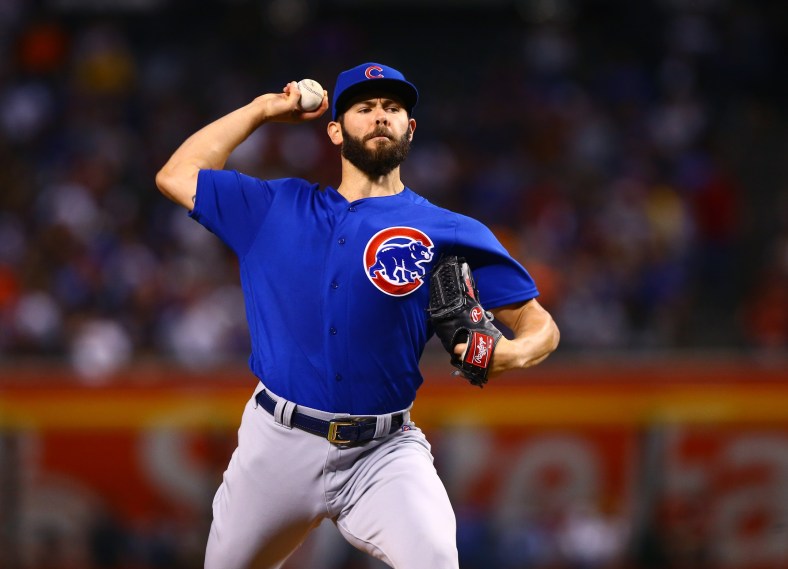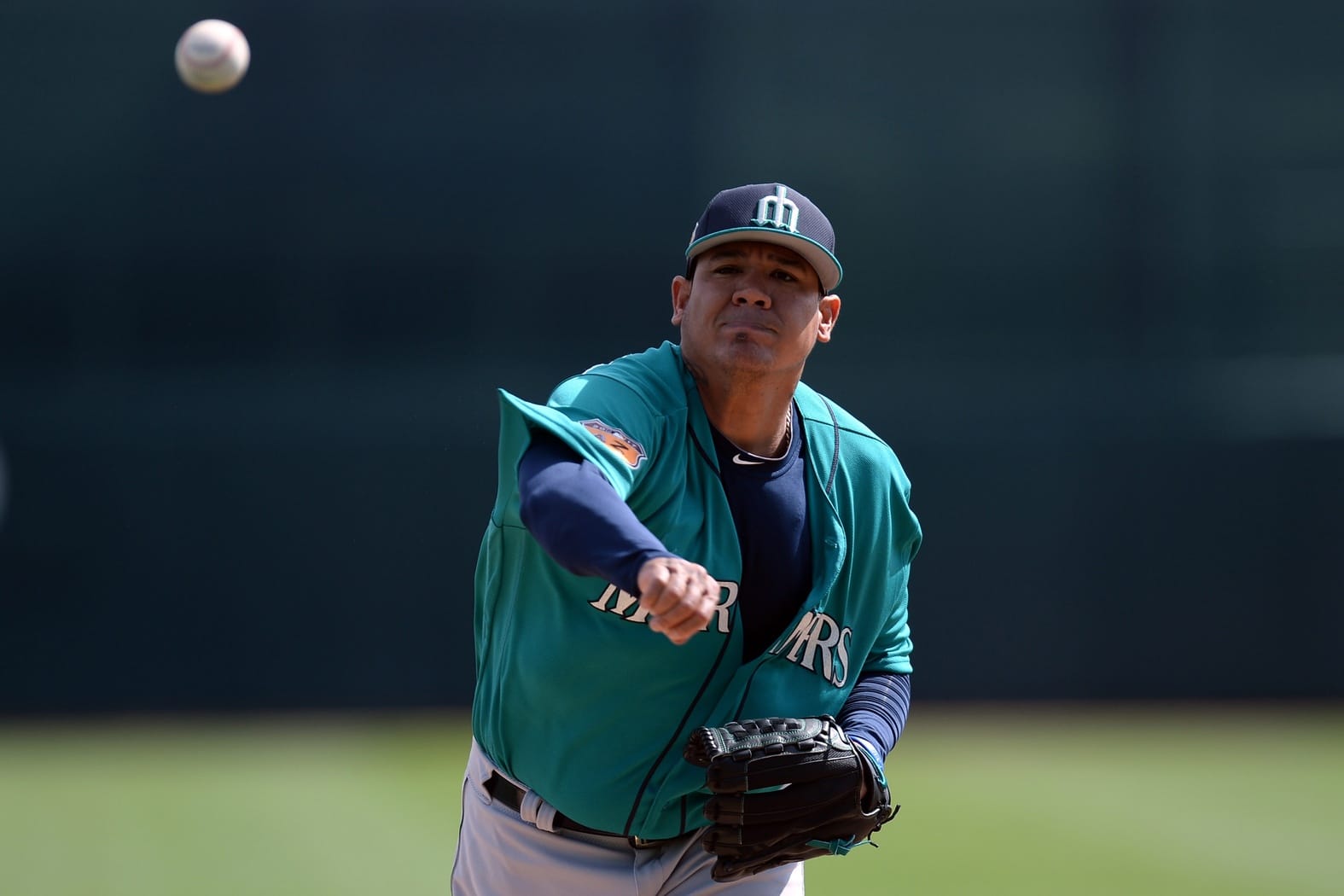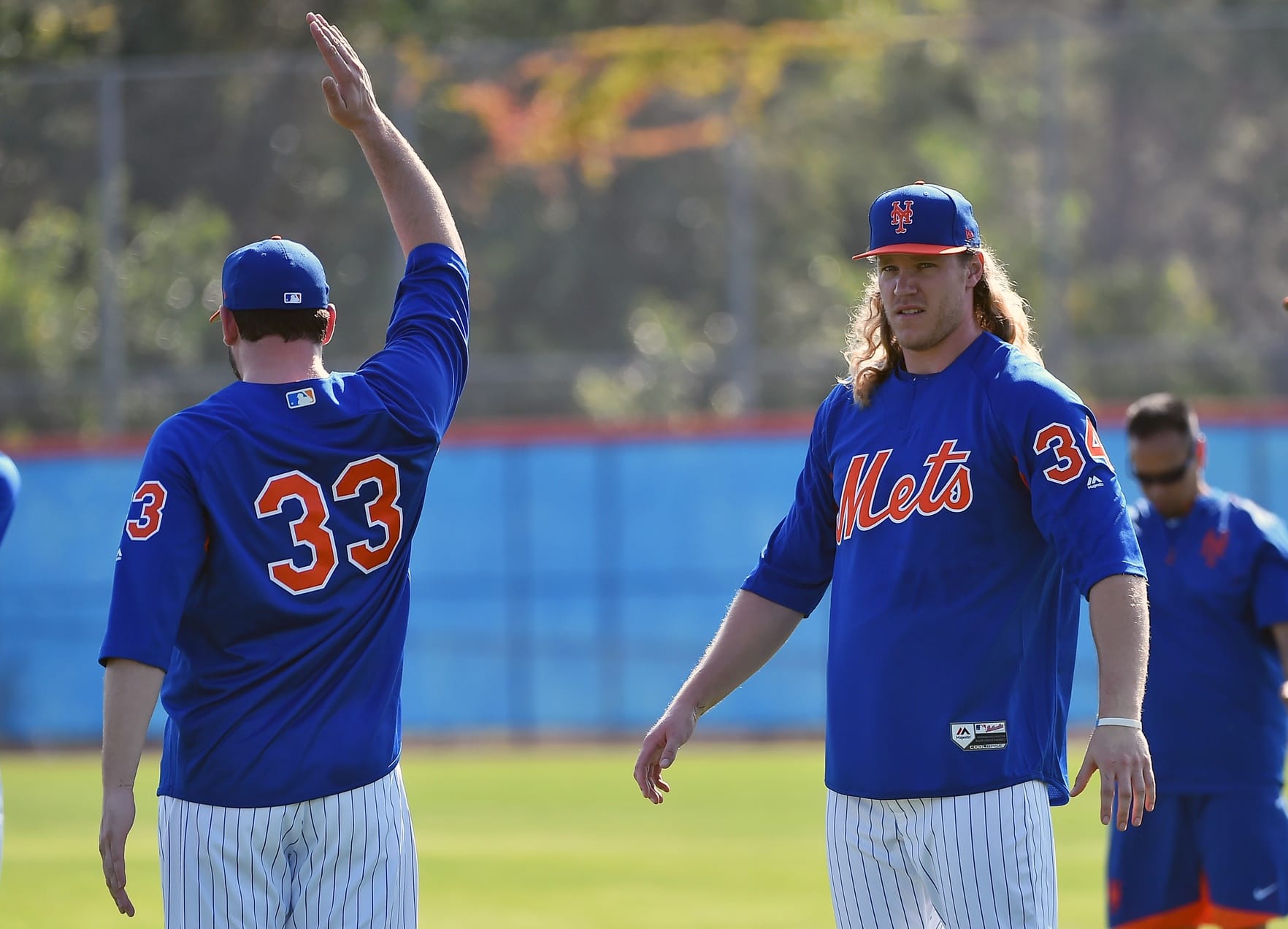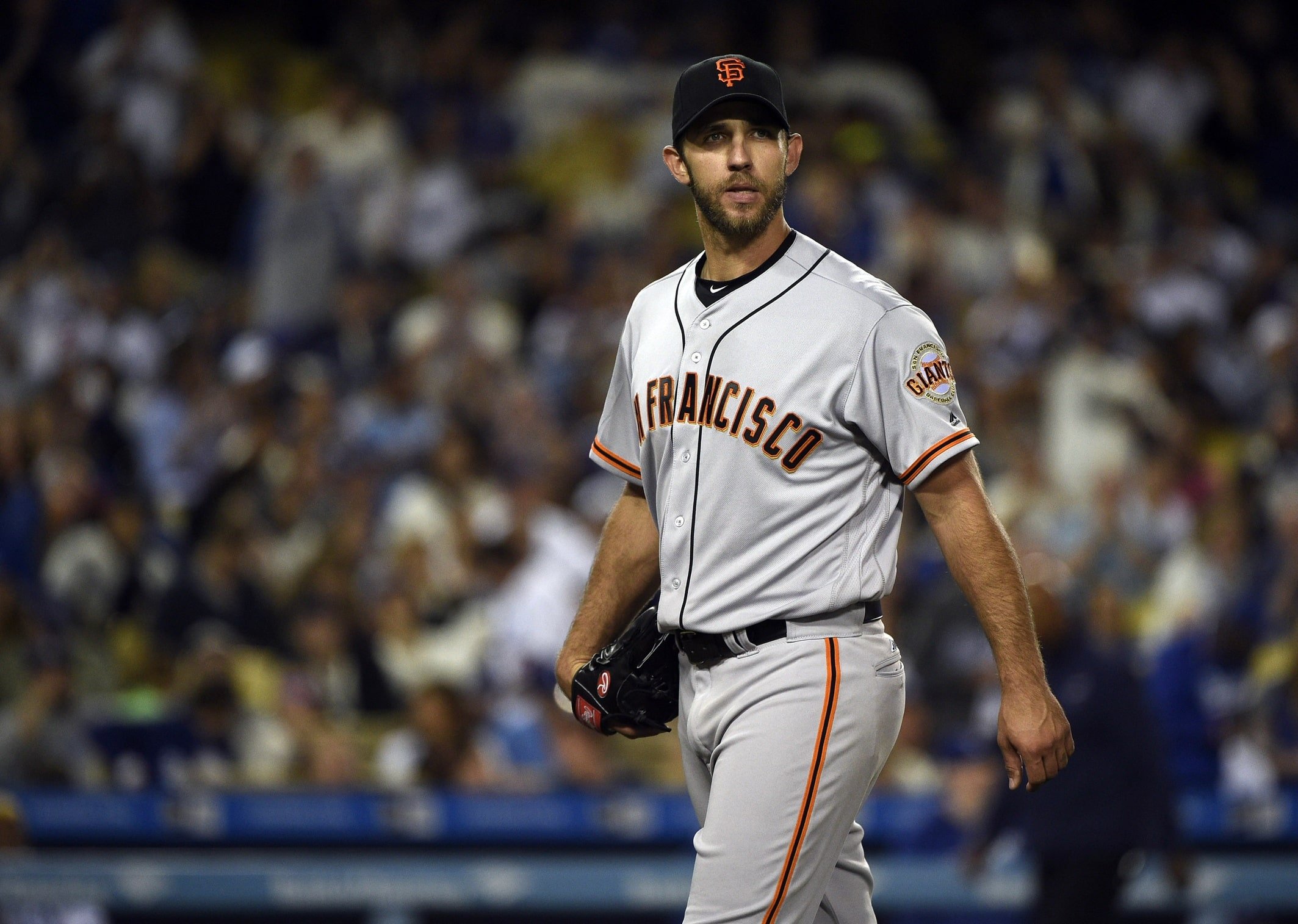
Offense so often grabs the headlines in baseball. Really, who doesn’t like seeing a 450-foot home run? But when it comes down to winning a World Series, pitching is key.
With the 2017 MLB season right around the corner, which teams have the best starting rotations?
Do the Giants, Dodgers or Nationals have the arms to top the Cubs in the National League? What about in the American League? Do teams like the Astros, Red Sox, and Blue Jays have the rotations to equal the Indians?
Entering the 2017 MLB season, who are the top-10 starting rotations?
10. Seattle Mariners

For more than a decade now, conversations about Seattle’s pitching rotation have started with Felix Hernandez. His best days are behind him, but King Felix is still a strong front-line starter.
Hernandez also has better pitchers behind him than he’s had in past years.
Much like Hernandez, Hisashi Iwakuma is a few years past his prime. Still, he has a solid 3.76 ERA and 1.16 WHIP over the last three seasons.
Drew Smyly had a terrible season in 2016 with a 4.88 ERA and 1.27 WHIP. But entering 2016, he had a career 3.24 ERA and 1.17 WHIP. Given that Smyly is only 27, we’re willing to give him the benefit of the doubt and simply call 2016 a down year. If nothing else, he’s a solid middle of the rotation guy.
The bottom two spots are a little shakier. Still, pitchers like Yovani Gallardo, James Paxton, and Chris Heston all have potential to greatly strengthen the four and five spots.
9. Houston Astros
Houston has an abundance of young, explosive talent on offense. But pitching rotation is also one of the best that MLB has to offer.
It starts with Dallas Keuchel, who had a disappointing (and injury plagued) year in 2016. But over the 2014 and 2015 seasons, Keuchel had a 2.69 ERA, 1.09 WHIP and won the 2015 American League Cy Young Award. So while 2016 was bad, we’re not ignoring the previous great seasons.
After a sharp start to #SpringTraining, @kidkeuchy is ready to get back to #AceStatus: https://t.co/d5BEXNAeO0 pic.twitter.com/pEUha9mZy4
— MLB (@MLB) February 18, 2017
Behind Keuchel sits a very capable group of Collin McHugh, Lance McCullers and Charlie Morton. The fifth spot will be filled out by Mike Fiers, Joe Musgrove or Brad Peacock.
Top to bottom, Houston’s staring rotation is a group with a good mixture of steady arms and undeniable potential.
8. Toronto Blue Jays
When looking at the names in the rotation, it doesn’t seem like Toronto belongs on a list like this. It’s not that Aaron Sanchez, Marco Estrada, J.A. Happ, Marcus Stroman and Francisco Liriano are bad pitchers. But it’s not a rotation with many established stars.
The names may not quite be awe inspiring. But the numbers are.
Sanchez, Estrada, Happ, Stroman and R.A. Dickey started all but 10 games for Toronto in 2016. Behind that starting five, the Jays had MLB’s fourth-lowest ERA (3.64) and fifth-best WHIP (1.22). Both totals were American League bests.
The only change is that 2017’s rotation will feature Liriano instead of Dickey, who’s now in Atlanta. That’s a sizable upgrade for Toronto. Additionally, Sanchez and Stroman are still developing arms and only figure to get better over the next few seasons.
The Blue Jays have been defined largely by their hitting over the past several seasons. With the loss of Edwin Encarnacion, the offense will likely take a bit of a dip. Still, don’t count Toronto out.
The Blue Jays’ offense still has plenty of thunder to help score runs. On the other side of the ball, the rotation figures to once again be pretty good at preventing them.
7. New York Mets

A lot can change in a year. Heading into 2016, the New York pitching staff had just led the Mets to a World Series appearance, shutting down the vaunted Cubs’ offense to get there. New York owned baseball’s best starting rotation by a wide margin.
What changed?
In terms of names, not a lot. Noah Syndergaard, Jacob deGrom, Matt Harvey and Steven Matz all remain from the Mets’ National League championship team. What makes New York so low on this list is the injuries that befell the staff in 2016.
Syndergaard was the only Met who remained healthy through the year. Given the youth of the rest of the rotation, we have to wonder how Terry Collins is going to use them in 2017. Remember, New York has been fairly cautious with these arms when they were healthy. With three of them coming off of season-ending injuries, it stands to reason that Collins will be extra conservative.
With that said, the Mets have too much talent to be ranked any worse than this. Syndergaard has Cy Young stuff. Even with a down year in 2016, Harvey still has a sub 3.00 career ERA. In the 2015 All-Star Game, deGrom showed just how dominant he could be against the league’s best bats.
Jacob deGrom is the first pitcher in All-Star Game history to strike out three batters in an inning in 10 pitches or fewer. #Mets
— Anthony DiComo (@AnthonyDiComo) July 15, 2015
Even with 2016’s injuries, these are pitchers that MLB hitters dread facing. The injury concerns are legitimate. Still, this is one of baseball’s most-feared rotations.
6. Washington Nationals
Washington is a lot like its NL East rival from New York. The talent in this rotation is undeniable. No team in its right mind would volunteer for a playoff series against Max Scherzer and Stephen Strasburg. But questions exist in Washington.
Strasburg has spent a lot of his career on the injured list. He’s failed to reach even 150 innings in each of the last two seasons. Can he put it together for a full, 200-inning season in 2017?
Scherzer is a genuine stud. But even if Strasburg has a strong season, can the remaining rotation of Gio Gonzalez, Tanner Roark, and either Joe Ross or A.J. Cole hold up against rotations that seem a lot deeper?
The talent is immense and the Nats don’t have quite the same questions throughout the rotation as the Mets. Washington unquestionably boasts one of the league’s best rotations in 2017. If Strasburg is healthy, it’s a top-five rotation. If not, it’s still one of the best of the rest.
5. Boston Red Sox
Make no mistake, questions exist around Boston’s starting rotation.
Can David Price bounce back from a dismal 2016 season? Is Rick Porcello a great pitcher or simply a good one who had a great season? Chris Sale’s talent is unquestionable, but how will the mercurial pitcher handle the microscope that is the Boston media?
These are all fair questions. Still, facts are facts.
Price is a Cy Young Award winner. Despite Kate Upton’s unhappiness, Porcello is, as well. Sale has never won a Cy Young Award, but has finished sixth or better in voting in each of the last six seasons.
Steven Wright, Drew Pomeranz, and Eduardo Rodriguez aren’t quite that accomplished. But any two of them are fine bottom of the rotation guys.
There are reasons to be skeptical. But entering 2017, Boston’s starters won’t take a backseat to many teams in terms of both front-end talent and back-end depth.
4. Los Angeles Dodgers
Let’s get one thing straight right right now. Baseball has a lot of great starting pitchers. But while his postseason numbers are a little troubling, Clayton Kershaw is the best pitcher in the game.
With Kershaw’s power and control, he’d be a great starter with even average off-speed pitches. But Kershaw’s off-speed repertoire is anything but average.
This is @ClaytonKersh22.
Be scared of him. #Nasty pic.twitter.com/9TRfmsRxk0
— MLB (@MLB) February 25, 2017
After Kershaw, the rotation takes a bit of a drop — although it’s certainly not bad.
Rich Hill will be 37 on opening day and has battled injuries in recent years. Still, between the Dodgers and Oakland Athletics, he posted a 2.12 ERA, a sub 1.00 WHIP and struck out 10.5 hitters per nine innings in 2016.
Kenta Maeda also put up big numbers — posting a 3.48 ERA, 1.14 WHIP and striking out 179 hitters in 175.2 innings. His numbers are a little alarming when we note that his second-half ERA (4.25) was more than a point worse than his first half mark (2.95). Still, it’s worth noting that Japanese pitchers often struggle with the longer MLB season in their rookie campaigns. Maeda certainly showed his potential. Now he has a better idea of how to pace himself.
The bottom spots in this rotation are the true wilds cards. Can Julio Urias go deep into games this year? Will Hyun-Jin Ryu regain his 2013-2014 form. If not, can veterans Scott Kazmir and Brandon McCarthy step up?
The Los Angeles’ pitching staff has some questions, which keeps it from a better ranking. Still, any rotation with Kershaw fronting it with this much two-through-five potential can’t be ranked any worse.
3. Cleveland Indians
The 2015 postseason let everyone know how good the Mets’ starting rotation was. In a strange way, the 2016 postseason did the opposite for the Indians.
The Cleveland bullpen received the bulk of the attention during 2016’s run to the American League pennant. Frankly, the dominance of Bryan Shaw, Cody Allen and especially Andrew Miller deserved ample praise.
But going back to 2014, the Tribe’s top three of Corey Kluber, Carlos Carrasco and Danny Salazar have been pretty dominant in their own right.
Over the last three years, Corey Kluber, Carlos Carrasco, and Danny Salazar have been nasty for the #Indians pic.twitter.com/5yXDjjbTrK
— Sportsnaut (@Sportsnaut) February 28, 2017
As good as all of those numbers are, the and walks are strikeouts really eye popping.
Three starting pitchers averaging more than a strikeout an inning is quite unique, especially in the American League.
A 2.4 BB/9 rate, meanwhile, is pretty good for a control pitcher. Power pitchers are frequently above three. The fact that over the last three years, these three combined have never been above three walks an inning shows how dominant they really are.
As was the case with the Mets and Nationals, injuries are a bit concerning.
Carrasco missed all of the 2016 postseason, while Salazar appeared in only two playoff games.
But those three — along with Josh Tomlin and Trevor Bauer — make for a formidable starting rotation in Cleveland. It’s a group that could absolutely bring the Indians to another World Series in 2017.
2. San Francisco Giants

Madison Bumgarner, Johnny Cueto and Jeff Samardzija did work for the Giants in 2016. San Francisco’s top-three starters combined for a 3.09 ERA, 1.10 WHIP and 8.5 strikeouts per nine innings.
Getting Matt Moore for a full season will also help the Giants. In 2016, he posted a 4.08 ERA and 1.33 WHIP in 12 starts for San Francisco. Moore really enjoyed pitching at AT&T, posting a 3.16 ERA and 1.19 WHIP while striking out nearly a hitter an inning.
So, the front four spots are all solid. What about the No. 5 spot? That figures to be a battle between former ace Matt Cain as well as rookies Ty Blach and Tyler Beede.
Cain hasn’t really been an ace since 2012 and hasn’t pitched a full season since 2013. So while he’ll likely break camp in the No. 5 spot, Blach and Beede will be hot on his heels.
Blach pitches to contact, which is normally alarming. But pitching in San Francisco makes that a little less of a problem. Things are almost always slanted towards the pitchers at AT&T Park.
Beede is raw and has dealt with some control issues. But he issued only 3.2 free passes per nine innings in Double-A last season. Getting to the majors will mean working with Dave Righetti — one of baseball’s best pitching coaches and someone who could help teach Beede better command.
San Francisco already has a strong quartet and could work its way into a lethal quintet. The Giants have one of baseball’s best rotations. We just can’t quite put them ahead of our next group.
1. Chicago Cubs
As good as these other rotations are, it would be impossible to justify any other team occupying the top spot.
In 2016, the #Cubs starting rotation was a cut above the rest pic.twitter.com/iKN4Jz87Zp
— Sportsnaut (@Sportsnaut) February 27, 2017
When we look at the staff, it’s not hard to see how those numbers came about.
Jake Arrieta and Jon Lester are both true aces. Either would be a clear No. 1 starter in most rotations around Major League Baseball.
Hendricks doesn’t have quite the same track record, but he posted a league-best 2.13 ERA in 2016 and has a career mark of 2.92. He may not be a full-fledged ace yet. But at 27, he’s an ace in the making.
John Lackey’s best days are behind him. But over the last three seasons, he’s posted a 3.29 ERA, 1.185 WHIP and has struck out 519 batters in 604.1 innings. He may not be an ace anymore. But as far as No. 4 starters go, you can’t get a lot better than that.
Mike Montgomery is currently in line to occupy the No. 5 spot, replacing the departed Jason Hammel. In 2016, Montgomery posted a 2.52 ERA, 1.17 WHIP, and struck out nearly a hitter an inning. As a starter, his strikeout rate was even better. Although the ERA and WHIP were slightly worse, a 3.28 ERA and 1.178 WHIP are significantly better than what you’d expect from a No. 5 starter. So, as good as Hammel was for the Cubs, Montgomery can be even better.
It’s also worth remembering that Chicago has one of baseball’s best farm systems. So even if Lackey doesn’t pan out or Montgomery struggles, the Cubs have the necessary trade assets to add rotation depth.
Chicago is going to be awfully hard to beat in 2017 and for a while after. The depth of the starting rotation is one of the main reasons for that.